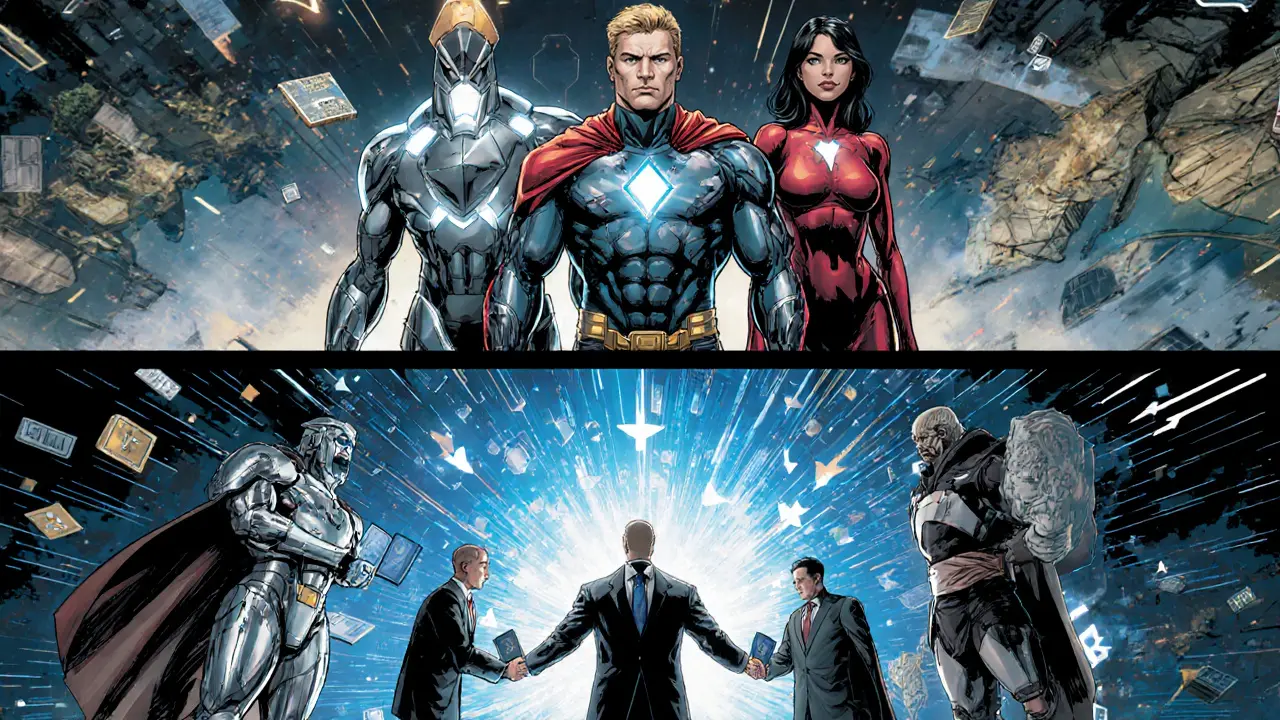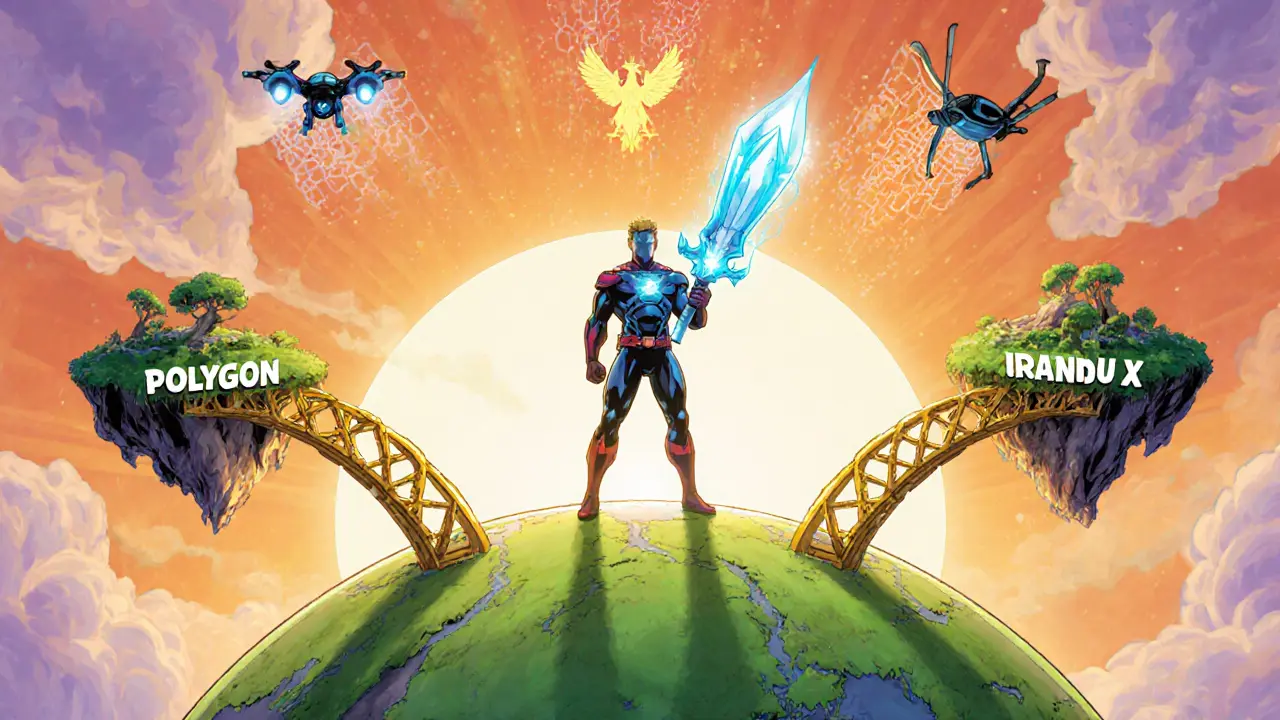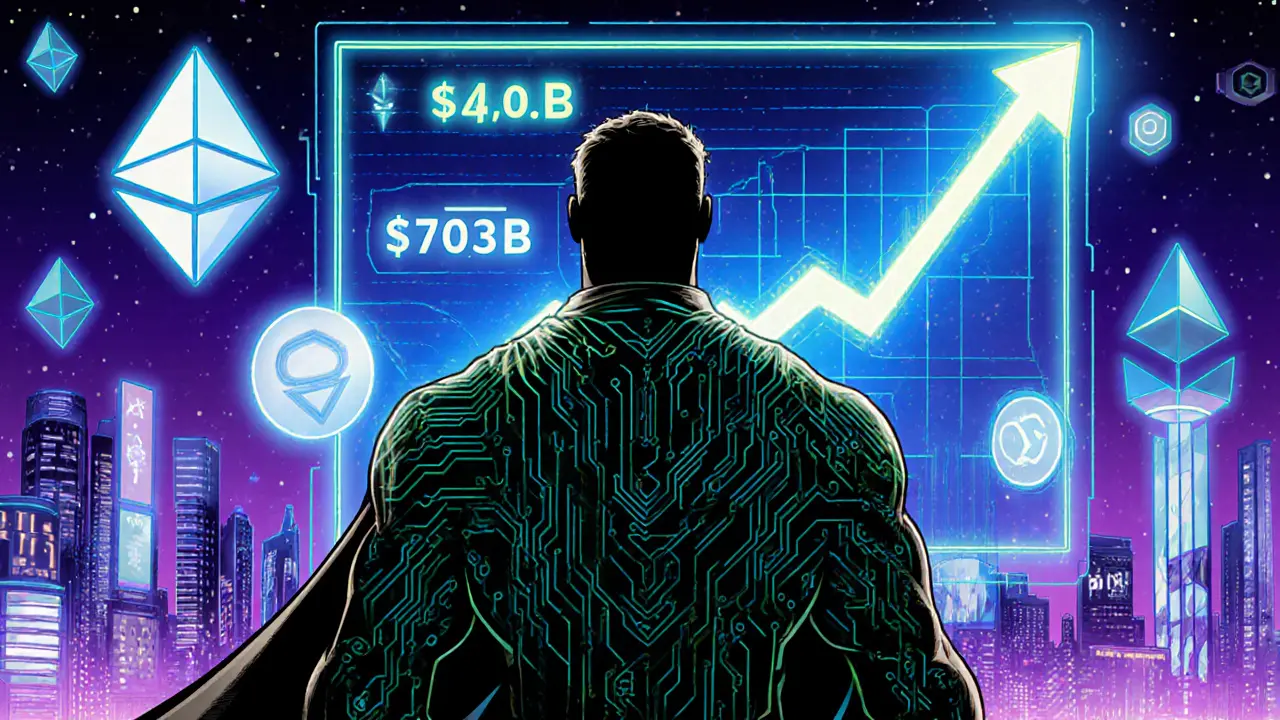Gaming NFT Market Growth Calculator
Projected Market Size
Ever wonder why gamers keep hearing about NFTs? The gaming NFT market isn’t a fad-it's morphing into a multi‑billion‑dollar ecosystem that blends real ownership with virtual play. Below you’ll get the numbers, the tech, the players, and the risks, so you can decide whether to jump in or sit this one out.
Key Takeaways
- The global gaming NFT market was worth $4.8billion in 2024 and is projected to hit $703billion by 2034, a 34.5% CAGR.
- Ethereum, Polygon, Immutable X, and Ronin lead the blockchain infrastructure, with most projects now on proof‑of‑stake chains to curb energy use.
- Play‑to‑earn models have generated $200‑$800 monthly incomes for players in emerging economies, but high gas fees remain a friction point.
- Venture capital poured $3.2billion into gaming NFT startups in 2025, and major publishers like Epic Games and Microsoft are testing blockchain features.
- Interoperability and AI‑driven dynamic NFTs are the next big wave, promising assets that evolve across games.
Market Overview & Recent Numbers
When you look at the broader NFT universe-valued at $48.74billion in 2025-gaming NFTs claim the lion’s share. They account for 38% of all NFT transactions, generating $12.9billion in revenue last year. Compared to art NFTs (21% share, median sale $1,200) and PFPs (37% share), gaming NFTs move faster: the average hold time is just 30‑45 days versus 180+ days for art.
Geographically, North America drives 41% of transaction volume, while the Asia‑Pacific region leads in daily active users and virtual land purchases. Virtual parcels in metaverses like Decentraland a blockchain‑based virtual world where land is tokenized as NFTs have sold for over $1million, though most plots sit between $500 and $50,000.
Growth Projections Through 2034
Analysts at Messari forecast $50billion in annual transaction volume for gaming NFTs by 2027. The compound annual growth rate (CAGR) from 2025‑2034 sits at 24.8%, pushing total market value to $703.47billion. This outpaces the overall gaming industry’s 8‑12% growth, suggesting blockchain integration could become a core revenue stream rather than a side project.
Investment firms are betting heavily: Andreessen Horowitz (a16z) has earmarked over $600million for gaming NFT startups, while Sequoia Capital and Binance Labs together invested $1.2billion in 2025 alone. These capital flows are fueling both indie projects and big‑studio experiments.
Technical Infrastructure: From Ethereum to Eco‑Friendly Chains
Early gaming NFTs were built almost exclusively on Ethereum the leading smart‑contract platform, originally proof‑of‑work but now moving to proof‑of‑stake. The high gas fees and energy concerns pushed developers toward Layer‑2 and side‑chain solutions.
Today, the top platforms include:
- Polygon a Layer‑2 scaling solution offering low fees and fast finality
- Immutable X a zero‑gas, carbon‑neutral layer built for NFTs on Ethereum
- Ronin Axie Infinity’s sidechain optimized for gaming transactions
Smart contracts now support automated royalty splits, fractional ownership, and cross‑chain bridges that let assets hop between Polygon, Binance Smart Chain, and even Solana. Developers typically spend 3‑6 months mastering these tools before launching a live product.

Key Players & Ecosystem Highlights
While many indie studios are experimenting, a handful of heavyweights dominate market share. The top six-Activision Blizzard, global game publisher integrating NFTs into titles like Call of Duty, Axie Infinity play‑to‑earn pioneer with 2.8million monthly active users, Bandai Namco Entertainment developer of popular franchises such as Pac‑Man entering NFT space, Dapper Labs creators of CryptoKitties and NBA Top Shot, now expanding into gaming, Electronic Arts big traditional publisher cautiously re‑entering NFTs after 2024 pause, and The Sandbox user‑generated voxel world where land and items are NFTs-collectively hold roughly 15‑20% of the market.
Platforms like Epic Games owner of Unreal Engine, now partnering with Polygon for NFT support in Fortnite are poised to expose hundreds of millions of players to blockchain features.
User Experience: Adoption, Pain Points, and Success Stories
Reddit’s r/GameFi community (85k members) reports a 68% positive sentiment toward ownership and earn‑while‑play mechanics. Players in the Philippines and Venezuela have turned games like Axie Infinity into a $200‑$800 monthly income source-sometimes outpacing local wages.
Yet friction remains. High transaction fees during network spikes, complex wallet setups, and the learning curve (averaging 2‑3 weeks for traditional gamers) deter mainstream adoption. Steam’s 2021 ban on NFT titles forced developers to seek alternatives like the Epic Games Store, which now hosts several blockchain titles.
Pro gamers share a checklist for newcomers:
- Pick a well‑documented game (e.g., Gods Unchained a competitive card game where cards are NFTs).
- Secure a reputable wallet (MetaMask or Trust Wallet) and back up your seed phrase.
- Use Layer‑2 solutions or sidechains to keep gas fees low.
- Start with a small budget, track royalty earnings, and avoid hype‑driven projects.
Investment Landscape & Business Models
Beyond direct game sales, NFT integration creates new monetization streams: token‑gated content, secondary‑market royalties, and virtual real‑estate leasing. Smart contracts distribute up to 10% of each resale back to creators-an incentive that’s hard to ignore for developers.
Venture capital is flowing fast. In 2025, $3.2billion was invested across 45 gaming NFT startups, with seed rounds averaging $8million and SeriesA reaching $35million. Notable deals include a $250million SeriesB for a cross‑chain metaverse platform backed by a16z and Sequoia.
However, regulators are tightening. The EU’s MiCA framework now classifies NFTs used for in‑game assets as “digital assets,” demanding transparency on tokenomics and anti‑money‑laundering checks. In the U.S., the SEC’s stance varies by state, prompting developers to embed KYC flows where required.
Future Outlook: Interoperability, AI, and Sustainability
2025‑2026 will be the tipping point. Epic’s Polygon integration means Fortnite players could own, sell, or trade skins across any Polygon‑compatible game. Cross‑chain bridges (e.g., Wormhole, Axelar) are enabling assets to move from Ethereum to Binance Smart Chain in seconds.
AI is also reshaping NFTs. Procedurally generated weapons that level up based on player behavior are now minted as dynamic NFTs, unlocking a new class of “living” assets that change rarity over time.
Environmental concerns are finally being addressed. Most new projects launch on proof‑of‑stake chains, which cut energy use by >99% compared to proof‑of‑work. Some platforms even purchase carbon credits to claim net‑zero status.
Bottom line: If blockchain gaming can deliver seamless UX and genuine player value, the $703billion forecast by 2034 looks realistic. The next 18 months will decide whether mainstream publishers fully commit or retreat.
| Chain | Consensus | Avg. Tx Fee (USD) | Speed (sec) | Eco‑Score |
|---|---|---|---|---|
| Ethereum primary smart‑contract platform (post‑merge proof‑of‑stake) | Proof‑of‑Stake | 0.5‑1.0 | 12‑14 | Medium |
| Polygon Ethereum Layer‑2 scaling solution | Proof‑of‑Stake | 0.001‑0.01 | 2‑3 | High |
| Immutable X Zero‑gas NFT layer on Ethereum | Proof‑of‑Stake (via StarkEx) | 0 (gas‑free) | 1‑2 | High |
| Ronin Axie Infinity sidechain | Proof‑of‑Authority | 0.02‑0.05 | 4‑5 | Medium |
Next Steps for Players, Developers, and Investors
Players: Start small, use a Layer‑2 wallet, and focus on games with strong communities like Gods Unchained a competitive card game where cards are NFTs or The Sandbox a user‑generated voxel world with NFT land. Track royalty splits and be ready for occasional gas spikes.
Developers: Choose a chain with solid SDKs (Polygon or Immutable X) and design tokenomics that reward long‑term play, not speculation. Leverage the Blockchain Game Alliance for compliance checklists and best‑practice templates.
Investors: Look for projects with cross‑chain bridges, AI‑enhanced asset generation, and clear regulatory strategies. Diversify across infrastructure (layer‑2) and high‑growth titles rather than chasing hype tokens.

Frequently Asked Questions
What is a gaming NFT?
A gaming NFT is a unique, blockchain‑backed token that represents in‑game assets-like characters, skins, weapons, or virtual land-giving players verifiable ownership and the ability to trade them outside the game.
Which blockchains are best for gaming NFTs?
Ethereum remains popular, but high fees push many developers to Layer‑2 solutions like Polygon, zero‑gas platforms like Immutable X, or sidechains such as Ronin. Proof‑of‑stake chains are favored for sustainability.
Can I earn real money playing NFT games?
Yes, especially in play‑to‑earn titles. Players in regions like Southeast Asia have reported $200‑$800 monthly earnings, though income varies widely and depends on market conditions and game design.
What are the main risks of getting into gaming NFTs?
Risks include volatile token prices, high transaction fees during network congestion, potential regulatory changes, and the learning curve of managing crypto wallets securely.
How will AI affect gaming NFTs?
AI enables procedurally generated, evolving NFTs that change based on player behavior. This creates dynamic rarity and opens new monetization models where assets improve over time.


tim nelson
May 30, 2025 AT 14:50The rise of gaming NFTs is giving players real stakes in virtual assets, and the market’s rapid expansion reflects that shift.
Zack Mast
May 31, 2025 AT 13:03The blockchain hype feels like a shiny coat over old loot boxes, yet the data shows a legit surge in digital ownership.
Dale Breithaupt
June 1, 2025 AT 11:16Key takeaway: a 34.5% CAGR means developers should think about NFT integration now to capture future growth.
Rasean Bryant
June 2, 2025 AT 09:30The projected $703 billion valuation by 2034 marks a watershed moment for interactive entertainment.
With a compound annual growth rate of 34.5%, the sector is outpacing most traditional gaming revenue streams.
This momentum is being driven by mainstream studios experimenting with play‑to‑earn mechanics.
Players are increasingly valuing true ownership of in‑game items, which NFTs uniquely enable.
Blockchain interoperability is also lowering barriers for cross‑game asset migration.
As ecosystems mature, transaction fees are dropping, making micro‑transactions feasible.
Moreover, secondary markets are emerging where rare skins fetch prices comparable to physical collectibles.
The data suggests that early adopters who integrate NFT layers will benefit from network effects.
Community‑driven governance models are giving players a voice in game development decisions.
This participatory approach fosters deeper engagement and longer player lifespans.
However, regulatory scrutiny around digital assets remains a pivotal factor.
Clear guidelines could boost institutional confidence and unlock additional capital.
On the technology front, layer‑2 solutions are addressing scalability concerns.
Environmental impact debates are also being mitigated by proof‑of‑stake implementations.
In summary, the convergence of blockchain, digital ownership, and innovative gameplay creates a fertile ground for exponential growth.
Stakeholders who stay informed and agile are poised to ride this wave into the next decade.
Angie Food
June 3, 2025 AT 07:43Another overhyped trend that will probably crash.
Jonathan Tsilimos
June 4, 2025 AT 05:56The integration of non‑fungible tokens within gaming architectures necessitates robust token standards and secure smart contract frameworks. Industry consensus aligns around ERC‑721 and ERC‑1155 specifications to ensure interoperability across platforms. Scalability considerations underscore the adoption of layer‑two solutions to mitigate latency constraints inherent in blockchain consensus mechanisms. Financial modeling indicates that tokenized assets generate ancillary revenue streams through royalty mechanisms embedded in smart contracts. Accordingly, stakeholders are advised to allocate development resources toward token economics design and regulatory compliance frameworks. This strategic emphasis fosters sustainable ecosystem growth while mitigating exposure to speculative market volatility.
jeffrey najar
June 5, 2025 AT 04:10If you're looking to get started, focus on a single blockchain that offers developer tools and a low barrier to entry; many indie studios find Polygon or Solana useful for quick prototyping. Build a simple NFT skin, test the minting flow, and gather player feedback before scaling up. Remember that community engagement is just as important as the technology itself, so keep communication channels open and iterate based on what players enjoy.
Rochelle Gamauf
June 6, 2025 AT 02:23While the advice to begin with low‑cost blockchains is practical, it overlooks the long‑term considerations of network security and user trust; premium platforms like Ethereum, despite higher fees, provide a proven track record that cannot be dismissed lightly.
Jerry Cassandro
June 7, 2025 AT 00:36Recent reports indicate that over 60 % of new blockchain games prioritize cross‑platform asset portability, leveraging standards such as ERC‑1155 to allow players to move items between titles seamlessly. This trend is accelerating the formation of shared metaverse ecosystems where NFTs serve as a common lingua franca.
Parker DeWitt
June 7, 2025 AT 22:50Sure, the numbers look flashy 🌟 but remember every bull market has its bear 🐻-investors should keep a level head and not chase hype 🚀.
Allie Smith
June 8, 2025 AT 21:03i kinda feel like the whole nft thing is a digital echo of ancient barter, just with pixels and code, ya know?
Lexie Ludens
June 9, 2025 AT 19:16The market frenzy is nothing short of a theatrical tragedy, with hype actors shouting louder than any real utility could ever whisper.
Aaron Casey
June 10, 2025 AT 17:30From a cultural diffusion perspective, gaming NFTs act as vectors for transnational digital identity exchange, and leveraging interoperable token standards will catalyze a more inclusive metaverse.